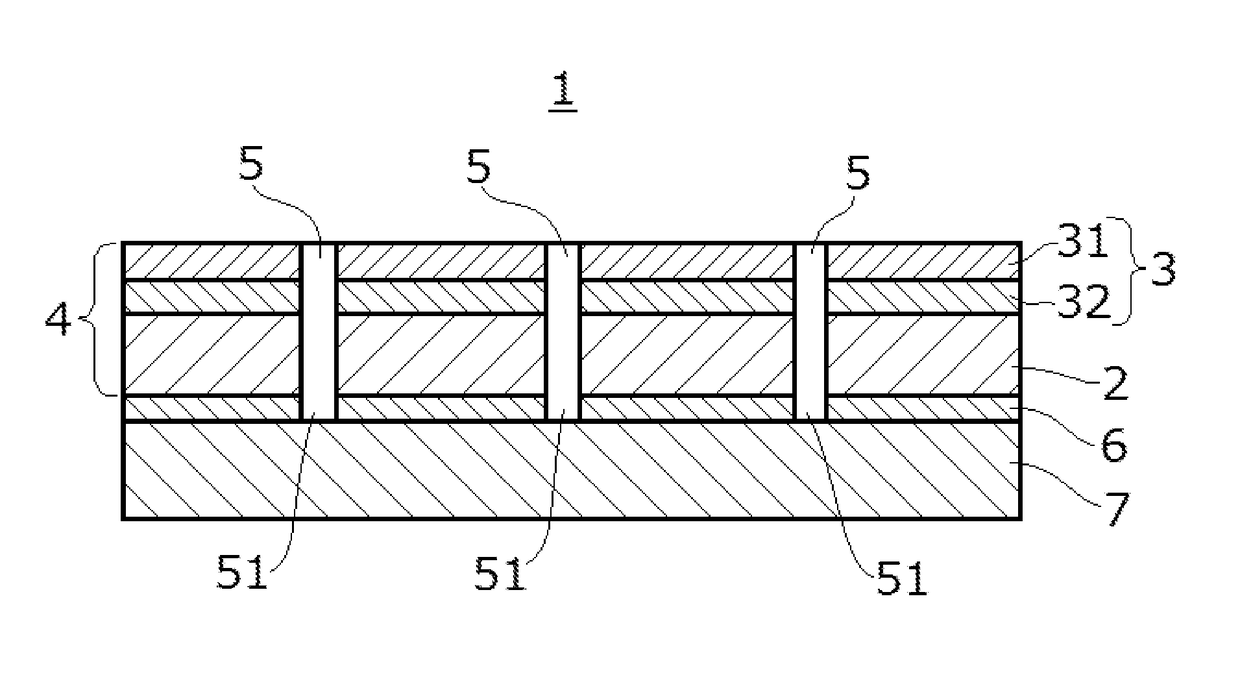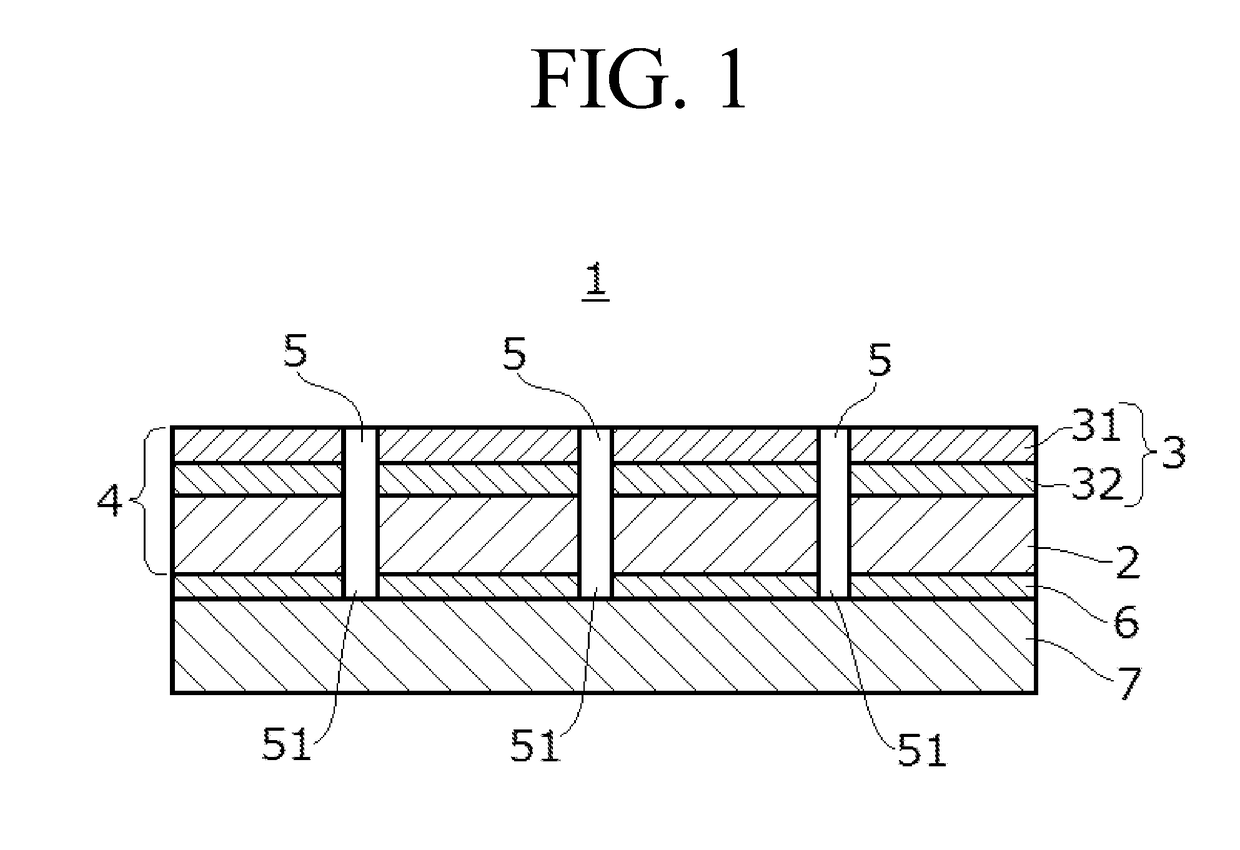Composite skin material for vehicle
a technology for composite skin and vehicle body, applied in the field of composite skin material for vehicles, can solve the problems of generating stuffiness and stickiness, limiting the constitution of fibrous substrates, and unable to obtain the strength necessary for vehicle interior materials, etc., and achieve the effect of removing stuffiness and stickiness
- Summary
- Abstract
- Description
- Claims
- Application Information
AI Technical Summary
Benefits of technology
Problems solved by technology
Method used
Image
Examples
example 1
[0059]40 Parts by mass of dimethyl formamide were added to 100 parts by mass of a polycarbonate-based polyurethane resin (CRISVON NY-328 manufactured by DIC Corporation) to adjust a viscosity to about 2,000 mPa·s. Thus, a polyurethane resin liquid was prepared. The polyurethane resin liquid was applied to a release paper in a coating thickness of 200 μm, followed by drying at 130° C. for 2 minutes. Thus, a skin resin layer comprising a polyurethane resin was formed.
[0060]50 Parts by mass of dimethyl formamide were added to 100 parts by mass of a polycarbonate-based polyurethane adhesive (CRISVON TA-205 manufactured by DIC Corporation) to adjust a viscosity to about 4,500 mPa·s. The resulting adhesive resin solution was applied to the skin resin layer formed above in a coating thickness of 200 μm, followed by drying at 100° C. for 1 minute. Thus, an adhesive resin layer was formed. The adhesive resin layer thus obtained was laminated on a knitted fabric (tricot stitch made of polyest...
example 2
[0064]A composite skin material was obtained in the same manner as in Example 1, except for using a plain weave fabric (warp: polyester spun yarn of 14 count two folded yarn, density: 31 yarns / 25.4 mm and total count number per 1 inch: 0.226; weft: polyester spun yarn of 10 count two folded yarn, density: 35 yarns / 25.4 mm and total count number per 1 inch: 0.143).
[0065]The composite skin material obtained had air permeability of 45 cm3 / cm2·s, and could eliminate stuffiness and stickiness when used as a vehicle interior material over a long period of time. Furthermore, the composite skin material had tear strength of 73N in a warp direction and 76N in a weft direction, and tensile strength of 155 N / cm in a warp direction and 186 N / cm in a weft direction. Thus, the composite skin material obtained had tear strength and tensile strength sufficient as a vehicle interior material, and was excellent in durability.
example 3
[0066]A composite skin material was obtained in the same manner as in Example 1, except for using a plain weave fabric (warp: polyester spun yarn of 14 count two folded yarn, density: 49 yarns / 25.4 mm and total count number per 1 inch: 0.143; weft: polyester spun yarn of 10 count two folded yarn, density: 44 yarns / 25.4 mm and total count number per 1 inch: 0.114).
[0067]The composite skin material obtained had air permeability of 28 cm3 / cm2·s, and could eliminate stuffiness and stickiness when used as a vehicle interior material over a long period of time. Furthermore, the composite skin material had tear strength of 110N in a warp direction and 131N in a weft direction, and tensile strength of 193 N / cm in a warp direction and 277 N / cm in a weft direction. Thus, the composite skin material obtained had tear strength and tensile strength sufficient as a vehicle interior material, and was excellent in durability.
PUM
| Property | Measurement | Unit |
|---|---|---|
| thickness | aaaaa | aaaaa |
| tensile elongation | aaaaa | aaaaa |
| thickness | aaaaa | aaaaa |
Abstract
Description
Claims
Application Information
 Login to View More
Login to View More - R&D
- Intellectual Property
- Life Sciences
- Materials
- Tech Scout
- Unparalleled Data Quality
- Higher Quality Content
- 60% Fewer Hallucinations
Browse by: Latest US Patents, China's latest patents, Technical Efficacy Thesaurus, Application Domain, Technology Topic, Popular Technical Reports.
© 2025 PatSnap. All rights reserved.Legal|Privacy policy|Modern Slavery Act Transparency Statement|Sitemap|About US| Contact US: help@patsnap.com


